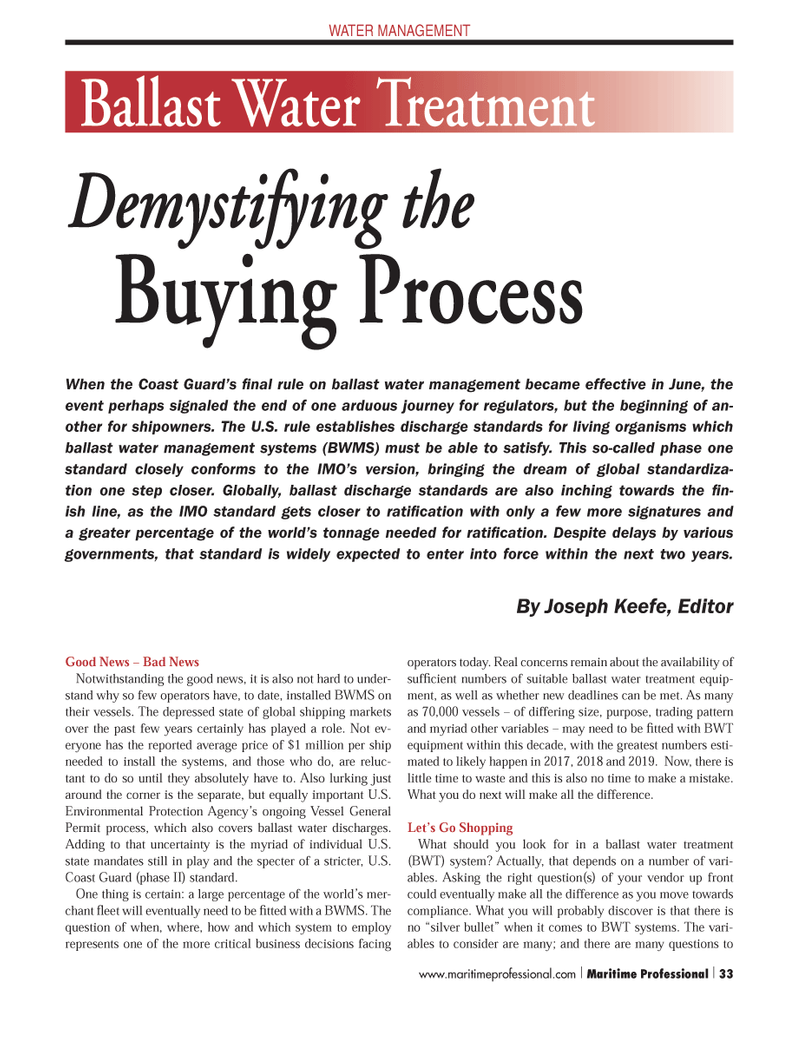
Page 33: of Maritime Logistics Professional Magazine (Q3 2012)
Classification Societies, Quality & Design
Read this page in Pdf, Flash or Html5 edition of Q3 2012 Maritime Logistics Professional Magazine
Good News ? Bad NewsNotwithstanding the good news, it is also not hard to under- stand why so few operators have, to date, installed BWMS on their vessels. The depressed state of global shipping markets over the past few years certainly has played a role. Not ev- eryone has the reported average price of $1 million per ship needed to install the systems, and those who do, are reluc-tant to do so until they absolutely have to. Also lurking just around the corner is the separate, but equally important U.S. Environmental Protection Agency?s ongoing Vessel General Permit process, which also covers ballast water discharges. Adding to that uncertainty is the myriad of individual U.S. state mandates still in play and the specter of a stricter, U.S. Coast Guard (phase II) standard.One thing is certain: a large percentage of the world?s mer- chant eet will eventually need to be tted with a BWMS. The question of when, where, how and which system to employ represents one of the more critical business decisions facing operators today. Real concerns remain about the availability of suf cient numbers of suitable ballast water treatment equip- ment, as well as whether new deadlines can be met. As many as 70,000 vessels ? of differing size, purpose, trading pattern and myriad other variables ? may need to be tted with BWT equipment within this decade, with the greatest numbers esti-mated to likely happen in 2017, 2018 and 2019. Now, there is little time to waste and this is also no time to make a mistake. What you do next will make all the difference. Let?s Go Shopping What should you look for in a ballast water treatment (BWT) system? Actually, that depends on a number of vari- ables. Asking the right question(s) of your vendor up front could eventually make all the difference as you move towards compliance. What you will probably discover is that there is no ?silver bullet? when it comes to BWT systems. The vari- ables to consider are many; and there are many questions to Demystifying the Demystifying the Buying Process Buying Process Ballast Water Treatment When the Coast Guard?s Þ nal rule on ballast water management became effective in June, the event perhaps signaled the end of one arduous journey for regulators, but the beginning of an- other for shipowners. The U.S. rule establishes discharge standards for living organisms which ballast water management systems (BWMS) must be able to satisfy. This so-called phase one standard closely conforms to the IMO?s version, bringing the dream of global standardiza- tion one step closer. Globally, ballast discharge standards are also inching towards the Þ n-ish line, as the IMO standard gets closer to ratiÞ cation with only a few more signatures and a greater percentage of the world?s tonnage needed for rati Þ cation. Despite delays by various governments, that standard is widely expected to enter into force within the next two years. By Joseph Keefe, Editor WATER MANAGEMENT www.maritimeprofessional.com | Maritime Professional | 33MP #3 18-33.indd 33MP #3 18-33.indd 338/15/2012 10:52:56 AM8/15/2012 10:52:56 AM

 32
32

 34
34
